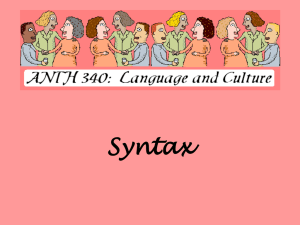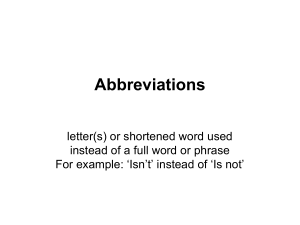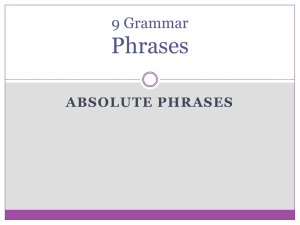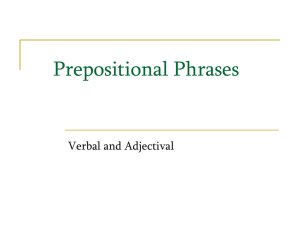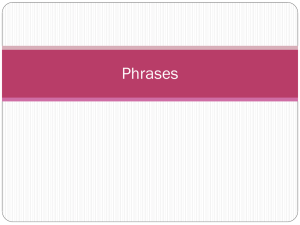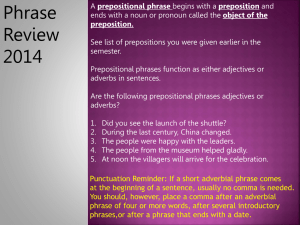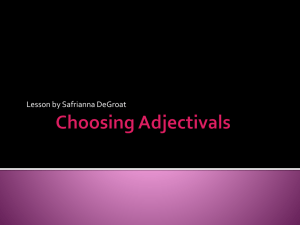Meeting 3 Noun Phrase & Constituents
advertisement
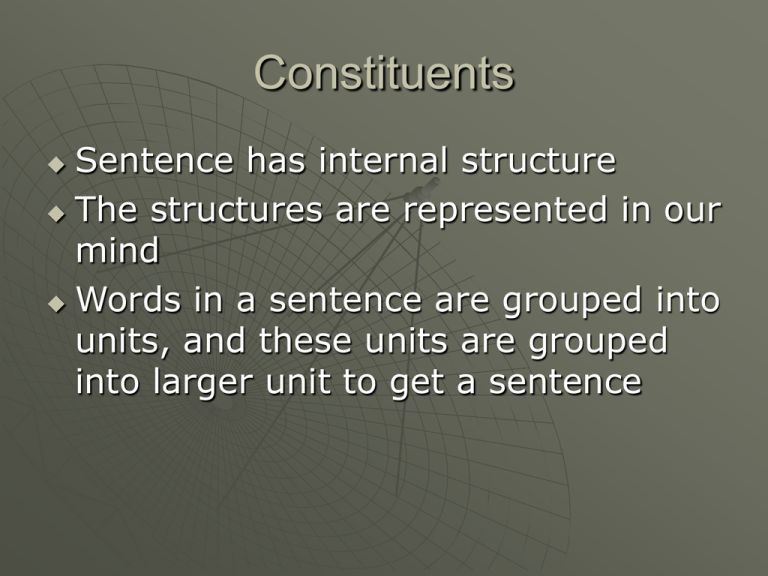
Constituents Sentence has internal structure The structures are represented in our mind Words in a sentence are grouped into units, and these units are grouped into larger unit to get a sentence Constituency and hierarchical structure A speaker of a language has intuition how a word is more likely to tie to another group Example: The students loved their syntax assignment Constituents: The students Their syntax assignment But not: *loved their How do we represent the bigger units Square bracket: [the student] Tree structure The student So, what is constituent? It is “a group of words that function together as a unit” It is the most important and the most basic notion in syntax theory containing the intuition of relatedness between constituents Can you draw a tree diagram of the sentence The student loved his syntax assignment Or a bracket rule (Chinese boxes)? End of Lecture 2a Phrase Structure In lecture 2a we looked at the concept of contituent. Today we’ll begin to look at how words combine to form sentences. WORD CLASSES OPEN/CONTENT nouns lexical verbs adjectives adverbs CLOSED/FUNCTIONAL /GRAMMATICAL determinatives prepositions pronouns auxiliary verbs Formal criteria: coordinators • morphological subordinators/ • syntactic complementizers Phrases • • • Words don’t combine together directly to form sentences. There’s a closer link between some words than there is with others. Words combine to form phrases and phrases combine with other words to form bigger phrases. Phrases S (1) The tall librarian put the book on that shelf • • the tall librarian goes together better than librarian put on that shelf forms a unit (or constituent) Phrases These sequences of words that go together like the tall librarian or on that shelf are called phrases. We can’t just throw words together in a random order - sentences have an ordered hierarchical structure. Words go together to form phrases, phrases go together to form larger phrases, then some phrases go together to form a clause or sentence. Phrases We can rely (to some extent) on intuition for our native language, but how do we work out phrases for a language we don’t speak? We need to use formal tests to work out which words in a sentence go together to form a phrase. Substitution Test This test involves substituting a single word for a string or sequence of words. If this substitution doesn’t change the meaning of the sentence, then the group of words we can replace with a single word is a phrase. Substitution Test We can see that a single word may be substituted for many of the phrases in sentence (1). The tall librarian put the book on that shelf She put the book on The tall librarian put The tall librarian put The tall librarian put that shelf it on that shelf the book on it the book there Substitution Test We’ve verified that the following are phrases: the tall librarian - substituted with she the book - substituted with it that shelf - also substituted with it on that shelf - substituted with there. Substitution Substitution is often used quite naturally to refer back to some previously mentioned referent. Substitution (3) Do you know the man who came yesterday? Yes, he’s my brother. In the answer to the question, we have replaced the man who came in yesterday with the pronoun he, which shows that the man who came in yesterday is a phrase. Substitution We can also substitute do so or so do (or just do/does/did) for a group of words which include the verb. o o o The tall librarian put the book on the shelf, and so did John. The tall librarian put the book on the shelf, and John did (so) too. Who put the book on that shelf? The tall librarian did (so). So the words put the book on the shelf in Cleft Test Cleft sentences have the form: It BE ____ that/who _____ It is/was/will be/has been ____ that/who ____ Note that we only change the original sentence by removing the phrase to be tested. Cleft Test It is/was/will be ____ that/who ____ The tall librarian put the book on that shelf It was the tall librarian who ___ put the book on that shelf It was the book that the tall librarian put ___ on that shelf It was on that shelf that the tall librarian put the book ___ Cleft Test It was the shelf that the tall librarian put the book on ___ *It was put the book on the shelf that the tall librarian ___ *It was put the book that the tall librarian ___ on the shelf. Cleft Test This test works by showing something is a phrase if it fits between it BE and who or that and still makes a grammatical sentence. PUZZLE: Phrase which includes the verb passes the substitution test, but fails the cleft test. Movement Tests Phrases often behave as units which can be placed at different positions in a sentence. We can think of the relationship between sentences as involving movement of phrases. The tall librarian put the book on that shelf On that shelf the tall librarian put the book ___ (whereas on this shelf she put the magazine ___.) The book the tall librarian put ___ on the shelf, Types of Phrases We now have some formal tests we can apply to find out whether or not a sequence of words forms a phrase. Now we’re going to look at the different types of phrases in languages, with their different internal structures. Noun Phrases These are all the same types of phrase: the sentence that boy a dog that large bicycle some dirty water women David Queensland happiness elderly men they Detv N Detv Adj N Adj N Pron N Noun Phrase The simplest NPs contain only a noun (proper noun [+proper] such as ‘John’, pronoun [+pron] such as ‘he’, mass noun [-count] such as ‘water’, or plural noun [+plural] such as ‘cats’) This generates a rule: NP N or NP N NP N S VP Noun Phrases In the previous examples, the most important word is a noun or pronoun. Noun/pronoun cannot be omitted Noun/pronoun may be the only element in a phrase So, since nouns are the most important words in the phrases, we call these phrases noun phrases. Noun Phrases In English, a noun phrase may be made up of: determinative + noun = NP (Detv) N determinative + adjective + noun = NP Detv Adj N noun adjective + noun pronoun Noun Phrases We use phrase structure rules to represent these structures, for example: NP Detv N This rule says that a noun phrase (NP) “is made up of” (arrow) a determinative (Detv) followed by a noun (N). Noun Phrase Another was of representing this formula is by using a phrase structure tree: NP Detv N Noun Phrases To account for the types of NP in (11): NP NP NP NP NP NP (Detv) N (Detv) (AdjP) N (Detv) (AdjP) N (PP) N (AdjP) N Pron Noun Phrases We can simplify this rule to: NP (Detv) (Adj) N (PP) This rule says that a noun phrase consists of a noun, with an optional determinative and adjective (in that order) preceding it and a prepositional phrase following it. Noun Phrases Note: This rule will not cover all possible English NPs (we’ll be modifying it shortly) but now we’ve got a structure to start with. A NP can consist of just a noun. When we see a noun in a sentence without a determinative or adjective, it is often in a noun phrase, even though it’s the only element of a noun phrase. Phrases We will look at phrases for all of the content words: Noun phrases Verb phrases Adjective phrases Adverb phrases and a phrase for one closed class word: Preposition phrases Adjective Phrases o o o That very happy woman left That woman is very happy So happy is that woman... In these sentences, the words very happy and so happy form a phrase. Adjective Phrase As with nouns and noun phrases, whenever we see an adjective in a sentence, we will say that it is a constituent of an adjective phrase (AdjP). A simple adjective phrase may consist of a Degree Adverb ( so, very, rather, extremely...) followed by an Adjective: AdjP (Adv) Adj Noun Phrases NP (Detv) (Adj) N We need to modify our NP structure rule because it has Adj on its own, and we now know that an adjective will always be in an AdjP. NP (Detv) (AdjP) N However… Noun Phrases Noun phrases can be much more complex than the examples given earlier. o o the very large man the rather quiet very large man So our new rule will be: NP (Detv) (AdjP)* N Adverb Phrases An adverb phrase normally consists of an adverb possibly preceded by a degree adverb: very quickly rather carefully extremely well Preposition Phrases Preposition phrases (PP) consist of a preposition (P) alone or with another constituent following it, often a noun phrase: to the shops after the party into the large kitchen beside those very large buildings Adverb phrases pass the substitution test with thus pass the cleft test pass the movement test She ran very slowly. She ran thus. It was very slowly that she ran ___. Very slowly she ran ___. Preposition Phrases A preposition doesn’t need to be followed by anything: o o John went outside. Pam stood behind. PP P (NP) Preposition phrase Prepositions may also be followed by Prepositional Phrases: James emerged from behind the shed. The monster arose from out of the mist. PP P PP Single formula: PP P (PP/NP) Preposition Phrase • Passes the cleft test o It was from out of the mist that the monster arose. • Passes the substitution test. o o The monster arose there. The monster arose from there. VERB PHRASES o • • The tall librarian put the book on that shelf. Recall that put the book on that shelf seemed to pass the substitution test (using do/does/did), but failed the cleft test. It also fails the movement test: Verb Phrase Assuming that the substitution test does identify the part of the sentence which includes the verb and everything that follows as a verb phrase (VP) then we have VP's of the following sort: Verb Phrases The girl left The girl went to the shops The girl kissed the boy The girl kissed the boy after lunch The girl kissed the boy after lunch under the tree The girl gave the boy a book The girl gave the boy a book after lunch The girl gave the boy a book after lunch under the tree Verb Phrases The girl left (V) The girl went to the shops (V + PP) The girl kissed the boy (V + NP) The girl kissed the boy after lunch (V + NP + PP) Verb Phrases The girl kissed the boy after lunch under the tree (V + NP + PP + PP) The girl gave the boy a book (V + NP + NP) The girl gave the boy a book after lunch (V + NP + NP + PP) Verb Phrases The girl gave the boy a book after lunch under the tree (V + NP + NP + PP + PP) Although these look like very complex structures, we can write them using one phrase structure rule: VP V (NP) (NP) (PP)* Verb Phrases VP V (NP) (NP) (PP)* Note: unlike our earlier rules where we used an asterisk (*) to indicate more than one of a constituent, we’ve written two NPs because in general no more than two NPs are found in a VP. This is not the case with the PPs, so we’ve used the asterisk there. Sentences A sentence may consist of an NP and a VP: S NP VP Sentences S NP VP [S [NP the tall librarian] [VP put the book on that shelf]] S NP VP Phrases in Sentences The tall librarian the book that shelf NP (Detv) (AdjP)* N The tall librarian put the book on that shelf. Phrases in Sentences The AdjP tall within the first NP the tall librarian consists simply of an adjective, one of the possibilities: AdjP (Adv) Adj The tall librarian put the book on that shelf. Phrases in sentences Let’s consider another more complex Adjective phrase: The librarian is so very extremely tall The librarian is rather quite exquisitely tall AdjP (AdvP) Adj AdvP (AdvP) Adv Phrases in Sentences The VP consists of a verb (V) followed by an NP and a PP, which conforms to our VP rule: VP V (NP) (NP) (PP)* Phrases in Sentences The PP on that shelf consists of a preposition (P) followed by an NP, which fits the PP rule: PP P (NP/PP) The tall librarian put the book on that shelf. Phrases in Sentences This small set of phrase structure rules that we’ve devised can account for many English sentences. To account for all sentences of English, we will have to develop more complex rules. Sentences Looking at our phrase structure tree (p7), we can see that sentences are made up of phrases rather than words, and that phrases may contain other phrases, showing us that sentences have an ordered hierarchical structure. In future lectures we will argue that S is also a phrase In next week's lectures we will look at ways of talking about the relations between the Further Reading: Carnie, Andrew. 2007. Syntax: a generative introduction. Chapter 3 Lee, David. 2003. Grammar survey, pp3-9, and chapters 3 and 5. Fromkin, V. et al. 2005. An Introduction to Language. Ch. 4.
